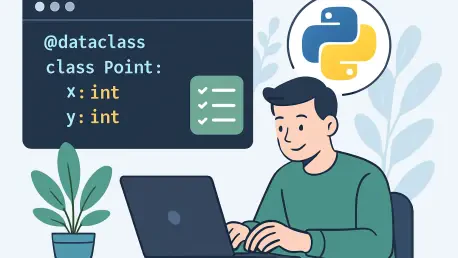In the fast-paced world of software development, where efficiency and clarity are paramount, Python developers often grapple with the challenge of writing repetitive, boilerplate code for class definitions. Imagine a scenario where a single project requires dozens of classes, each demanding manual setup for initialization and common methods—a task that consumes valuable time and introduces the risk of errors. This is where Python dataclasses step in, offering a transformative solution that has reshaped coding practices since their debut. Introduced as a standard feature in Python 3.7 and backported to 3.6, dataclasses have become a cornerstone for developers aiming to simplify class creation while maintaining robust functionality. This review delves into the intricacies of this powerful tool, exploring its features, real-world impact, and future potential.
Core Features That Define Dataclasses
Automatic Code Generation for Efficiency
At the heart of Python dataclasses lies the ability to automate repetitive tasks through the @dataclass decorator. This mechanism generates essential dunder methods such as __init__, __repr__, and __eq__ without manual intervention, significantly cutting down on code verbosity. For developers, this means focusing on logic rather than mundane setup, as the decorator handles the grunt work of initializing class attributes from constructor arguments.
Beyond mere convenience, dataclasses preserve type hints, ensuring compatibility with modern linting tools and static type checkers. This feature enhances code reliability by catching potential errors during development. Notably, runtime performance remains unaffected, with only a negligible overhead during class declaration, making this automation a practical choice for projects of any scale.
Customization Through Field Options
Flexibility is another hallmark of dataclasses, achieved through the field() function, which allows precise control over attribute behavior. Parameters such as default, default_factory, repr, and compare enable developers to tailor fields to specific needs, whether setting default values or excluding certain attributes from string representations or comparisons. Such customization ensures that dataclasses adapt to diverse requirements without sacrificing simplicity.
Practical applications of these options are abundant. For instance, a field might be omitted from comparison to focus equality checks on key attributes, or a default factory can initialize complex objects like lists. This granular control empowers developers to craft classes that are both minimalistic and highly functional, striking a balance between automation and specificity.
Advanced Initialization for Complex Needs
For scenarios requiring custom initialization logic, dataclasses offer the __post_init__ method, which runs after the auto-generated constructor. This allows for post-processing of attributes, such as conditional assignments or validations, ensuring that objects are fully prepared for use upon creation. It’s a powerful way to extend functionality without overriding the default setup.
Additionally, the InitVar type provides a mechanism to handle initialization-only parameters that aren’t stored as instance attributes. This is particularly useful for temporary data used during setup, keeping the class structure clean and focused. Together, these features make dataclasses versatile enough to handle intricate initialization patterns while maintaining their core simplicity.
Trends and Adoption in the Developer Community
Since their introduction, dataclasses have seen a steady rise in adoption among Python developers, becoming a go-to solution for reducing code clutter. Over recent years, community feedback has highlighted their value in enhancing readability and maintainability, with many praising the seamless integration into existing workflows. This growing acceptance is evident across forums and repositories, where dataclasses are often recommended as a best practice.
Modern Python tools and libraries have also embraced dataclasses, further cementing their relevance. Frameworks like FastAPI leverage them for defining request and response models, while data science libraries utilize them for structured data handling. This widespread integration reflects a broader trend toward streamlined, declarative coding styles in the ecosystem.
Emerging patterns reveal dataclasses being used for data modeling in diverse domains, from web development to machine learning. Their ability to replace older constructs like namedtuple or nested dictionaries has sparked innovative approaches to structuring data. As adoption continues to expand, dataclasses are shaping how developers conceptualize and implement class-based solutions.
Real-World Impact Across Industries
Dataclasses have found a home in numerous industries, proving their worth in practical applications. In web development, they are widely used to define API models, as seen with tools like FastAPI, where they simplify the mapping of JSON data to Python objects. This usage streamlines endpoint creation and validation, saving developers from writing extensive conversion code.
In data processing and scientific computing, dataclasses offer a cleaner alternative to dictionaries for managing nested or hierarchical data. Their structured nature improves code clarity, especially in collaborative environments where multiple developers interact with shared data models. This readability translates to fewer misunderstandings and faster onboarding for new team members.
Unique use cases also highlight their adaptability, such as serving as immutable data structures in place of namedtuple or facilitating complex object hierarchies in large-scale systems. By reducing the cognitive load associated with class design, dataclasses enable teams to focus on solving domain-specific problems, thereby enhancing overall productivity in real-world projects.
Challenges and Limitations to Consider
Despite their advantages, dataclasses are not a universal solution and come with certain drawbacks. One notable concern is their potential overuse in contexts where they add unnecessary complexity, such as in classes dominated by static methods or minimal data. In such cases, the benefits of automation may not justify the adoption of dataclasses.
Edge cases can also pose challenges, particularly when extensive customization is required. While options like field() and __post_init__ offer flexibility, they can lead to intricate setups that partially negate the simplicity dataclasses aim to provide. Developers must weigh these trade-offs when deciding whether to implement them in specific scenarios.
Ongoing discussions within the Python community point to areas for improvement, such as handling niche use cases or enhancing feature sets. Some argue for better support in dynamic attribute scenarios, while others seek clearer guidelines on best practices. These conversations underscore the need for careful consideration when integrating dataclasses into a codebase.
Future Potential and Evolution
Looking ahead, dataclasses are poised for further refinement, with potential enhancements driven by community input. Proposals for new features, such as improved support for dynamic fields or tighter integration with type systems, could address current limitations and broaden their applicability. Such developments would likely emerge in upcoming Python releases, aligning with evolving developer needs.
Their role in cutting-edge domains like machine learning and web frameworks is expected to grow, especially as data modeling becomes more central to these fields. Dataclasses could serve as a foundation for standardized patterns in handling complex datasets or API interactions, fostering consistency across projects. This trajectory suggests a deepening influence on how Python applications are architected.
Long-term, dataclasses are likely to redefine Pythonic coding practices by promoting a declarative approach to class design. As more developers adopt them, their impact on productivity and code quality will become even more pronounced, potentially setting a new benchmark for elegance and efficiency in programming. This evolution promises to keep dataclasses at the forefront of Python’s toolkit.
Final Reflections and Next Steps
Looking back, the journey of Python dataclasses stands out as a testament to the language’s commitment to developer-friendly innovation. Their ability to eliminate boilerplate code while offering robust customization has proven transformative across diverse applications. From web APIs to data science, they have carved a niche as an indispensable asset for modern coding challenges.
Moving forward, developers are encouraged to explore dataclasses in their projects, starting with small-scale implementations to gauge fit and scalability. Experimenting with their advanced features, such as custom initialization, offers a pathway to unlocking greater potential. Additionally, staying engaged with community discussions ensures access to emerging best practices and updates.
As Python continues to evolve, integrating dataclasses into standard workflows promises to streamline development processes further. Teams are advised to assess specific use cases, balancing automation benefits against complexity, to maximize their impact. This strategic adoption paves the way for sustained improvements in code maintainability and project efficiency.









